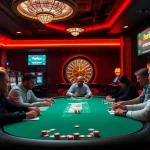Gambling at casinos has long been a captivating form of entertainment, attracting millions of people to the lively lights and sounds of gambling venues worldwide. But beneath the surface of the shine and sparkle lies a complex interplay of human behavior that influences how players participate in chance-based games. Understanding this psychology can uncover why so many are willing to bet their money in pursuit of payouts and the rush that gaming provides.
As we explore further into the world of gambling at casinos, we’ll examine the cognitive and affective factors that drive players’ decisions. From the intense rush of success to the sorrow of losing, the psychological feelings associated with gaming can be profound and complex. This analysis not only sheds light on what drives players but also discovers how casinos use these psychological principles to improve the overall gaming experience, creating an environment where players feel both excited and captivated.
The Attraction of Chance
The joy of casino gaming often rests in the random nature of fortune. Gamblers are drawn to the idea that with a one toss of the die, turn of the wheel, or flip of a card, their fortunes could shift significantly. This aspect of surprise creates an thrilling rush that many find irresistible. The psychological impact of not knowing the result adds to the thrill, making each moment in the gaming hall a possible decisive point in one’s luck.
The attraction of chance is further magnified by the importance of aspiration and dreams in human psychology. Individuals visit gambling houses not just to bet but to imagine of ideal situations where they become winners. DP568 that anyone can hit it big fosters a sense of opportunity, allowing individuals to escape their daily lives, even if just for a few hours. This dreaming aspect drives people to engage in casino gaming, where the stakes may be high, but the promise of a life-changing jackpot keeps them coming back.
Furthermore, the atmosphere of a casino enhances the attraction of luck. Dazzling lights, captivating sounds, and the spectacular display of games create a stimulating environment. This setting is designed to immerse gamblers, encouraging them to focus on the moment and take chances. In conjunction with the mental aspects of chance, this environment intensifies the intoxicating thrill of gambling, making casino gaming more than just a game of luck; it becomes an adventure where everything feels achievable.
Understanding Casino Player Conduct
Gaming gaming is a intricate relationship of feelings, choices, and mental triggers that draw players to the gaming floor. Each person approaches gambling with their unique history and incentives, ranging from entertainment to the excitement of possible financial gain. The appeal of instant returns can frequently overshadow the risks, making it easy for players to become immersed in the thrill of the experience. Comprehending these factors helps clarify why certain games capture focus more than the rest and why gamblers may remain engaged for prolonged periods.
A further crucial factor of gambler behavior is the impact of the environment. Gambling establishments are designed to be vibrant, exciting spaces that attract to the sensory perception. Bright illuminations, sounds of winning, and the general atmosphere create a sense of urgency and excitement. This carefully designed environment can lead to what studies call the "near-miss effect," where gamblers feel they are close to success, boosting their desire to continue playing. The communal engagements that occur in these environments, whether at a table game or in a slot machine area, additionally compound these feelings, creating a sense of belonging among players that can encourage lengthy involvement.
Moreover, personal mental characteristics significantly impact gambling conduct. Factors such as risk tolerance, impulse control, and optimism bias play key roles in how players engage with casino gaming. Some people may have a propensity to pursue their losses, thinking that they will eventually recover their losses, while others might exhibit more prudent approaches. Grasping these traits can provide insightful perspectives for both gamblers and casino operators, helping to develop safe gambling settings that cater to the diverse incentives and psychological profiles of their customers.
The Impact of Environment
The casino environment is meticulously designed to enhance the gaming experience and encourage prolonged play. From the moment guests enter a casino, they are greeted with bright lights, captivating sounds, and a diversity of colorful graphics. This sensory stimulation creates an inviting atmosphere that appeals to the emotions and draws players in. The carefully curated combination of sights and sounds aims to elicit excitement and anticipation, making it difficult for players to resist engaging with the games.
The layout of a casino also plays a significant role in affecting how individuals interact with the gaming space. Games are often strategically placed to maximize visibility and accessibility, fostering an environment where players feel compelled to try their luck. Furthermore, the absence of clocks and windows removes the awareness of time, allowing players to lose track of how long they have been gambling. This design element can lead to extended gaming sessions as the urgency of time is diminished, often resulting in increased spending.
Social dynamics within a casino can further influence gambling behavior. Many players are drawn to the communal aspects of gaming, where the energy of fellow gamblers can create a thrilling atmosphere. Interactions with dealers and other players can enhance the enjoyment of the experience, often leading to increased confidence and risk-taking behavior. The combination of these environmental factors highlights how the physical setting of a casino can significantly shape the psychology of casino gaming, fostering not only a sense of excitement but also influencing decision-making and financial outcomes.
